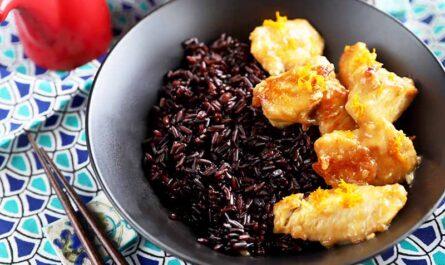If you’ve ever dined at a sushi restaurant or explored different types of rice, you might have come across the term forbidden rice. But what is forbidden rice, and why does it captivate the interest of culinary enthusiasts? In this article, we will delve into the intriguing history, nutritional benefits, and culinary uses of this exotic rice variety.

The Origins of Forbidden Rice
Forbidden rice, also known as black rice, has a rich history that dates back thousands of years. Legend has it that in ancient China, this rice variety was reserved exclusively for royalty due to its superior health benefits and unique flavor. It was forbidden for commoners, hence the name forbidden rice. Today, it is widely available, allowing everyone to enjoy its distinct qualities.
The Unique Characteristics of Forbidden Rice
Unlike common white or brown rice, forbidden rice is characterized by its deep purple-black color. This striking hue is due to the presence of anthocyanins, powerful antioxidants that are also found in blueberries and blackberries. When cooked, forbidden rice transforms into a beautiful dark purple color, adding a visually stunning element to any dish.
Nutritional Benefits of Forbidden Rice
One of the main reasons why forbidden rice has gained popularity is its exceptional nutritional profile. It is a whole grain, meaning it retains its bran and germ layers, which are rich in fiber, vitamins, and minerals. Here are some key nutritional benefits of forbidden rice:
Rich in Antioxidants
The anthocyanins present in forbidden rice act as potent antioxidants, helping to neutralize harmful free radicals in the body. These antioxidants have been linked to a reduced risk of chronic diseases, such as heart disease and cancer.
High in Fiber
Forbidden rice is an excellent source of dietary fiber, which aids in digestion and promotes a healthy gut. Consuming fiber-rich foods can also help regulate blood sugar levels and reduce the risk of type 2 diabetes.
Packed with Essential Nutrients
This rice variety is a good source of essential nutrients, including iron, vitamin E, and B vitamins. Iron is crucial for maintaining healthy blood cells, while vitamin E acts as a powerful antioxidant. B vitamins play a vital role in energy metabolism and brain function.
Culinary Uses of Forbidden Rice
Forbidden rice is incredibly versatile and can be used in a variety of dishes, from savory to sweet. Its nutty flavor and chewy texture make it an excellent addition to salads, stir-fries, and even sushi. Here are some popular ways to use forbidden rice:
Forbidden Rice in Sushi
For sushi lovers, forbidden rice can be a creative alternative to traditional sushi rice. Its striking color adds visual appeal to sushi rolls, making them a feast for the eyes as well as the palate. To learn more about perfecting sushi rice, you can visit perfect sushi rice tips.
Forbidden Rice Salads
Forbidden rice salads are a great way to enjoy the nutty flavor and chewy texture of this rice. Combine it with fresh vegetables, herbs, and a zesty dressing for a refreshing and nutritious meal. For more health benefits of black rice, check out this external resource.
Forbidden Rice Pudding
For a sweet treat, try making forbidden rice pudding. Cook the rice in coconut milk and sweeten it with honey or maple syrup. Top it with fresh fruits or nuts for a delightful dessert.
Comparing Forbidden Rice with Other Rice Varieties
When exploring different types of rice, it’s essential to understand how forbidden rice compares to other varieties. For instance, this comparison of sushi rice vs medium grain can provide valuable insights for sushi enthusiasts.
Forbidden Rice vs. White Rice
While white rice is a staple in many households, it lacks the nutritional benefits of forbidden rice. White rice has been stripped of its bran and germ layers, resulting in a loss of fiber, vitamins, and minerals.
Forbidden Rice vs. Brown Rice
Both forbidden rice and brown rice are whole grains, but forbidden rice offers a higher antioxidant content due to its anthocyanins. This makes it a more nutritious choice for those seeking to boost their antioxidant intake.
Cooking Tips for Forbidden Rice
Cooking forbidden rice is relatively simple, but there are a few tips to ensure the best results. Here are some helpful suggestions:
Rinse Thoroughly
Before cooking, rinse the rice under cold water to remove any excess starch. This will help prevent the rice from becoming sticky.
Use the Right Water-to-Rice Ratio
For optimal texture, use a 2:1 water-to-rice ratio. This means two cups of water for every cup of rice.
Simmer Gently
Once the rice reaches a boil, reduce the heat to a simmer and cover the pot. Allow it to cook for about 30-40 minutes until tender.
The Environmental Impact of Forbidden Rice
Choosing forbidden rice can have positive effects on the environment. It is often grown organically and requires less water than other rice varieties, making it a sustainable option for eco-conscious consumers.
Supporting Sustainable Farming
By purchasing forbidden rice from sustainable sources, consumers can support farmers who prioritize environmentally friendly practices.
Reducing Water Usage
The cultivation of forbidden rice generally requires less water compared to other rice types, contributing to water conservation efforts.

Frequently Asked Questions
Is forbidden rice gluten-free?
Yes, forbidden rice is naturally gluten-free, making it a suitable choice for individuals with gluten sensitivities or celiac disease.
Can forbidden rice be used in sushi?
Absolutely! Forbidden rice can be used as a substitute for traditional sushi rice, adding a unique flavor and color to sushi rolls.
Where can I buy forbidden rice?
Forbidden rice can be found in most health food stores, Asian markets, and online retailers. Be sure to choose organic options for the best quality.
This article contains affiliate links. We may earn a commission at no extra cost to you.




